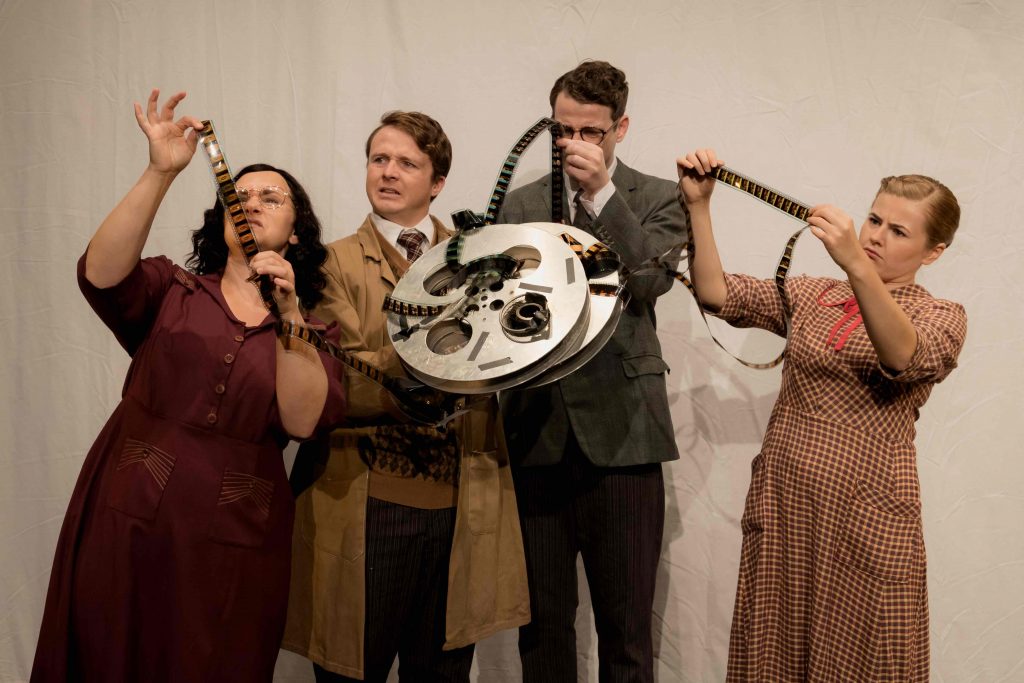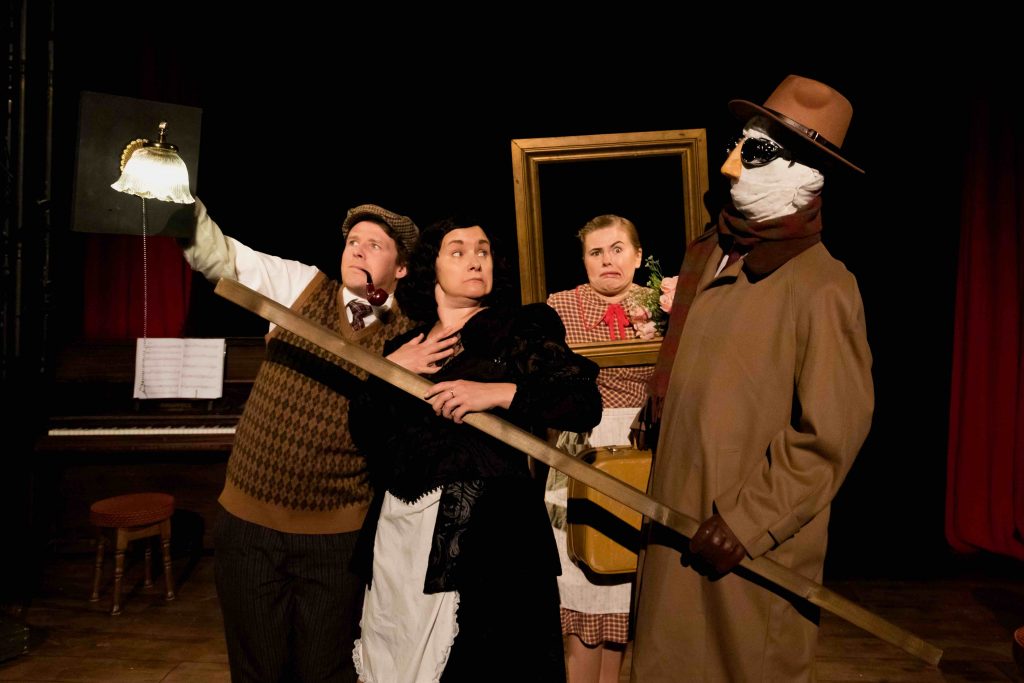Fast-paced physical comedy is very much the speciality of Black RAT Productions. This supersonic romp through H G Wells The Invisible Man, with other works by the sci-fi maestro thrown in, follows the company’s previous excellent forays into the genre that I have seen in recent years such as Loot, One Man Two Guvnors and The 39 Steps.
This is writer and director Richard Tunley comedy gold delivered with breath-taking vigour and pizzazz from a cast of just four players, Zoe Davies, Jemima Nicholas, Ryan Owen and Sam Jones, who take so many roles it is hard to keep count.
The concept of the play is Aberllanpencwm Workingman’s Hall (the show is again a co-production with excellent Blackwood Miners’ Institute) in 1933, the year the classic Claude Rains version of the film has just been released. There is huge excitement ts the Hall which shows the latest movies and the Black Rat show begins with the staff at the Valleys’ venue welcoming us, the audience, to watch the spine-chilling movie. However, a projector malfunction means the screening cannot go-ahead, so the resourceful staff decide to give an improvised live performance instead.
The humour comes from this double conceit of the plot of the film being performed with whatever props are at hand, the staff having to take on a baffling number of roles, switching from one to another and to yet another at neck-break speed, and then the interplay of the characters in and out of The Invisible Man film and Aberllanpencwm Hall roles. Does it sound wildly complicated? Indeed it is and there lies much of the humour.
Being based in a 1930s Welsh workingmen’s hall, the staff are a delightful gentle send up of the sort of characters that reflect the period but we all recognise even today. We are the local audience for the film and are welcomed by the pompous Aberllanpencwm manager Lloyd Williams played by Sam Jones and his chopsy usherette Maud, played by a fabulous Zoe Davies who natters away with us and local people she “knows”. Interestingly, the original stage version of The Rocky Horror Show had ghoulish ushers and usherettes showing people to their seats and the opening song, of course, references Claude Raine in The Invisible Man.
Rather than disappoint the crowd the manager ropes in the other staff members including Fanny who has even read the book, played by Jemima Nichols and no-nonsense projectionist/ electrician Alfie played by Ryan Owen.
As the telling of the tale gathers pace the action becomes increasingly farcical and the comedy becomes dependent on the multiple role-switching, as more and more new characters are introduced and the speed at which they have to exchange roles intensifies. Somehow the exuberate young players achieve the seemingly impossible, requiring impressive physical timing, vocal dexterity and that most difficult of acting skills, is to be genuinely funny.
The play also shows confidence in writing by throwing in some pretty dreadful puns and jokes to get appreciative groans from the audience. The involvement of the audience extends to inviting us to join the chorus of one of the Kieran Bailey composed daft songs the players perform.
Some of the humour follows well-known tropes (how can someone be one character while they have to be on stage as another, getting the wrong accent when switching roles, tiring of repeating the same actions such as to convey going up and down the stairs and mixing up props in that process, just changing hats to become different characters) but they are all very witty and executed with aplomb.
We also have some near panto-esque references to local places (Splott in the case of the Royal Welsh College of Music and Drama, Cardiff performance). As this is a tale of scientific experimentation having shocking results we have links made with current affairs (lockdowns, vaccinations, an invisible killer etc) delivered with knowing looks at the audience.
The mystery of the Invisible Man making things happen (candles being lit, glasses flying around, spooky goings on, are achieved through the skills of Stefan Pejic and lighting from Robin Bainbridge, all within Sean Crowley and Ruby Brown’s versatile designs.
There is always a twist in a spooky tale so as events in the Hall don’t always go as planned or as can be explained the cast are left asking “Was it really all science fiction?”.
The only question I asked myself was whether there was possiby too much going on in the second half?
This is one heck of an energetic show that makes huge demands of the four players and they carry it off with what seems mystifying ease and faultless delivery.

